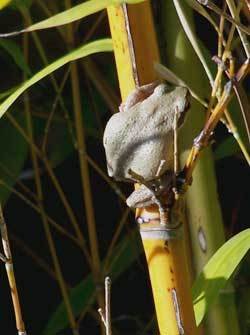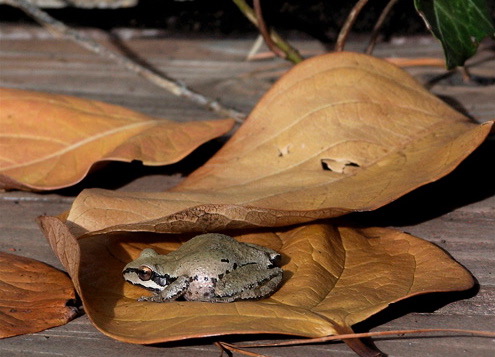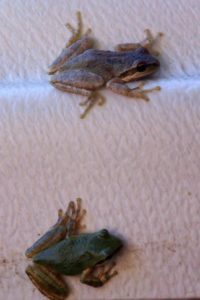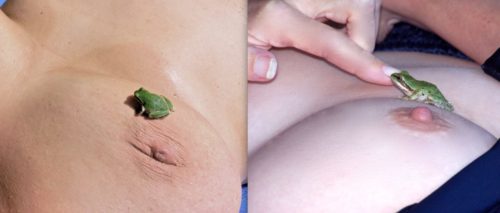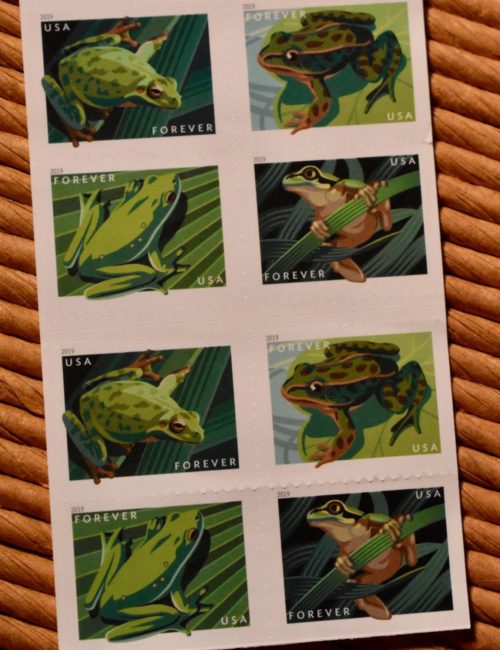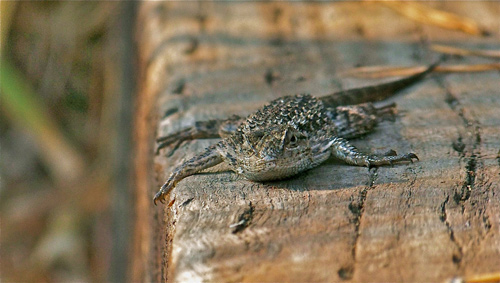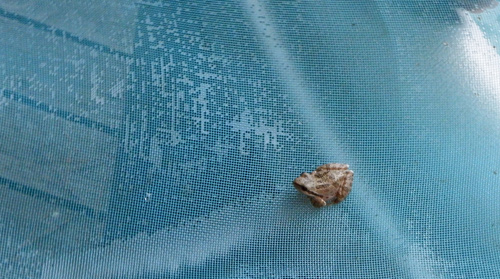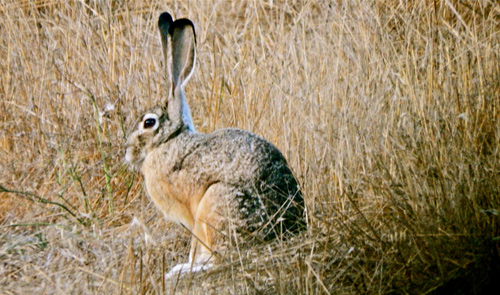
A Pacific tree frog after I rescued it from my hot tub.
When I opened the lid of my hot tub one day four years ago to check the amount of chlorine and other chemicals in the water, a tree frog that had been hiding between the lid and the top of the tub took a flying leap into the caldron.
At 104 degrees, the water is hot enough to quickly kill a frog. I’ve seen it happen. This time, however, I had a sieve with me and was able to scoop the frog out in time to save it.

A Pacific tree frog climbs a bamboo shoot growing near the hot tub. Lynn and I are fond of the little guys even though frogs aren’t exactly people. But as the Greek philosopher Bion (c. 325 to c. 255 BC) observed: “Though boys throw stones at frogs in sport, the frogs do not die in sport, but in earnest.”

Tree frogs change their colors as they move between dry and damp places. This frog is sitting on a dry persimmon leaf on the deck beside the hot tub.

When I lifted the lid off the hot tub, I found these two fellows squeezed under it. Notice that they are starting to change colors.

Tree frogs hanging out around a hot tub and the people soaking in it can occasionally create unlikely juxtapositions. Twice in years past, lady friends obliged this photographer by posing with frogs that showed up dazed from immersion in the hot water.

The U.S. Postal Service also recognizes how alluring frogs can be and featured four varieties on its “forever stamps” a year ago. I wish I’d bought more.
The autumnal equinox of 2014 is upon us. Fall has begun. If we were in Great Britain, still including Scotland (hip, hip, hooray), we would probably say that “autumn” has begun. Transatlantic linguistic differences, you know, old chap. Sort of like “truck” v. “lorry.”
Until the early 1600s, the English name for the season was “harvest,” but as more and more people moved off the farm and into cities where there was no harvesting, they began to call the season “fall of the leaf.” After all, it’s the time of year when leaves fall from trees. Eventually, the phrase was shortened to just “fall.”
From what I read, the word “autumn” is at least three centuries older, but its origins are unclear. However, the French word for “autumn” is “automne,” so that may be a clue.

The cold-blooded countenance of a Western Fence Lizard.
The mostly dry, mostly sunny days of summer’s end were welcomed by a cold-blooded crew of Western Fence Lizards that daily warm themselves on the railroad-tie steps leading up to Mitchell cabin.
I’ve seen as many as three lizards at a time on the steps. Some scoot out of sight the moment they feel the vibration of my tread, but some don’t move at all, forcing me to be careful I don’t step on them. Actually, I don’t think that’s likely. Their staying still as long as possible is probably a form of camouflage they would abandon if I got too close.

The Western Fence Lizard diet mostly consists of insects and spiders.
Their nickname is “blue bellies” because of the color of their undersides, which can be seen when the males do pushups. It’s their equivalent of pumping iron in order to impress females and intimidate other males.

A Pacific tree frog right after I rescued it from my hot tub.
When I opened the lid of my hot tub Thursday to check the amount of chlorine and other chemicals in the water, a tree frog that had been hiding between the lid and the top of the tub took a flying leap into the caldron.
At 104 degrees, the water is hot enough to quickly kill a frog. I’ve seen it happen. This time, however, I had a sieve with me and was able to scoop the frog out in time to save it.

Autumnal raccoon kits begging at the kitchen door.
Three raccoon mothers and their kits show up immediately after sunset each evening to dine on whatever rations we’re willing to provide, slices of bread, corn chips, peanuts etc.
The kits are curious enough about the source of this bounty that they’ll sometimes take a step or two into the house when Lynn or I open a door to toss them their rations. However, most of the raccoons back away the moment we get close. The exception is one mother who sits beside the door and uses her front paws to unhurriedly take slices of bread directly from our hands.

Four wild turkeys uphill from Mitchell cabin.
It would be fun to be able to call them turkeys in the straw, but they’re really turkeys in the hay. Straw is basically grass with its seeds removed.

In 1988, a hunting club working with the State Department of Fish and Game introduced non-native turkeys into West Marin on Loma Alta Ridge, which overlooks the San Geronimo Valley. By now, however, there are far more turkeys than turkey hunters, and their flocks have spread throughout West Marin.

A turkey pauses to dine on grass seeds.

A jackrabbit likewise dines on grass uphill from Mitchell cabin.
Jackrabbits, which are also known as black-tailed hares, avoid predators by using “an element of surprise and escape that works well,” Point Reyes Station naturalist Jules Evens notes in his Natural History of the Point Reyes Peninsula.
“When a potential predator is detected, the hare will usually take shelter in the shade of a convenient clump of vegetation or behind a rock and freeze motionless. If the predator approaches very closely, the hare leaps into stride, zigzagging across open country until it finds shelter.

Jackrabbits have been clocked running at up to 36 mph for short distances.
“The effect on the startled predator is momentary confusion, which may afford the hare the advantage it needs to escape.” Their smaller cousins, the cottontail rabbits, prefer brush to open land. They have “poor running ability,” Evens explains, and “frequently fall prey to foxes, bobcats, weasels, hawks, and owls.”

A four-point buck, probably about a year and a half old, also forages in the grass uphill from Mitchell cabin.
Columbian blacktail deer (Odocoileus hemionus columbianus) are the subspecies of blacktails native to the Bay Area,” Bruce Morris writes for Bay Nature. “According to the California Department of Fish and Game, there are now approximately 560,000 deer in all California, about 320,000 of which are Columbian blacktails….
“Blacktails have a typical lifespan in the wild of seven to 10 years, but they can survive in suburban habitat for as long as 17 to 20 years if unmolested,” Morris adds. “Suburban deer have minuscule home ranges, measuring three or four blocks for females whereas wild deer inhabit territories that extend for several miles.”
The other day I was walking up the front steps when I was so startled to see a deer right in front of me that I tripped and started to fall forward. Fortunately, I was able to catch myself and spring back, so I didn’t land on my nose. I’ll try to remember that sequence on Nov. 2 when daylight savings time ends and I have to reset the clocks.

